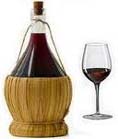How To Make Pates And
Terrines
from Italian Traditional Food
Advice on how to make pates and
terrines
Check out these great Italian ideas at Amazon for Italian food and kitchen ideas.
Here is some useful information on how to make pates and terrines. Pates are
savoury mixtures made principally from either chicken, calves or pigs liver with the addition of other meat,
poultry or game.
Pates and terrines can be smooth and velvety, or
coarse in texture. Pates and terrines are served cold as a first course, either scooped from the
pot with a spoon or cut in slices, and should be served on individual plates, with hot toast and pats of fresh
butter served separately.
A more substantial pate (similar to a galantine) is served as a main course with salads, or as a
dish for the buffet table. This type is sometimes called a terrine after the glazed earthenware casserole in which
it is cooked. A terrine can have sliced meat or game between the farce and all pates of this sort are lightly
pressed after cooking to make them easier to slice.
The meats for both pates and terrines should be well seasoned and have
a proportion of fat, a dash of brandy or sherry being added for additional flavour and to help them keep.
How to cook pates
Pates should be cooked tightly sealed so see that the mixture fills the casserole, and a luting
paste used to seal it well. This is a paste of flour and water mixed together to a soft, putty-like consistency and
spread with the fingers on the join between the lid and casserole. The casserole is then put into a roasting tin
half-filled with hot water, ie. a bain marie; the whole is then put into the oven and cooked according to the
recipe.
Read more Italian traditional food related articles here

Copyright © 2009 - . All Rights Reserved
Worldwide. Italian Traditional Food
You may not reprint articles from this website
without the written permission of the site owner.
Disclaimer: Articles on this
Website are provided for information purposes only. Italiantraditionalfood.com does not accept any responsibility
or liability for the use or misuse of the article content on this site or reliance by any person on the site's
contents.
| 


 Digg
Digg Stumbleupon
Stumbleupon Google Bookmarks
Google Bookmarks Delicious
Delicious Twitter
Twitter Facebook
Facebook Yahoo My Web
Yahoo My Web Reddit
Reddit